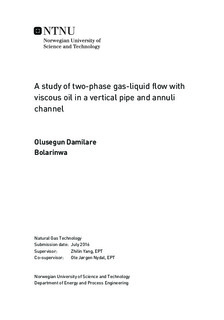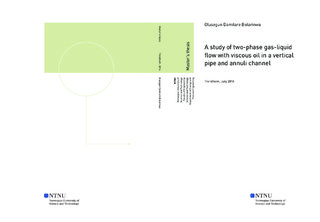| dc.description.abstract | The knowledge of gas-liquid flows in annulus geometries can be found in several applications such as the geothermal, nuclear, space, chemical and petroleum. Over time, the design of ducts with annulus geometries for transport of two phase gas-liquid flows has been dependent on the concept of the hydraulic diameter. This has, in many ways, led to oversizing of such ducts due to inadequate estimation of the friction factor of such annulus geometries. Flow pattern predictions for two phase flow in annulus geometries have also been explored but more work is still needed for better understanding of the subject.
The aim of this research is to examine single phase flow and two phase gas-liquid flow in annulus geometries. This research work was carried out at the new annulus geometry test rig at the Multiphase Flow Laboratory in the Department of Energy and Process, Norwegian University of Science and Technology. The inner diameter of the outer pipe is 90mm and the outer diameter for the inner pipe is 30mm. For single phase flow, experimental pressure drop measurements are made in a 6m horizontal annulus geometry set up to investigate the validity of existing models for estimating the friction factor and hence the pressure drop of annulus geometries based on several equivalent diameter concepts. Water and Oil are both used for the single phase flow experimental study. The Hydraulic diameter was inadequate to predict pressure drop in the annulus test section. However, the Knudsen diameter performed best and is suitable for prediction of the measured single phase pressure drop and friction factor in the annulus test section. For two phase gas-liquid flow, experimental investigation is carried out to observe flow patterns in a 6m inclinable annulus rig set up for angles of 15, 30, 45 and 60 degrees. This is done for both air-water and air-oil mixtures. Flow pattern maps are generated. It was observed that the angle of inclination, size of duct and viscosity of the working liquid all play have a considerable effect on the flow regimes observed, flow regimes transitions points and size of each flow regime region on flow pattern maps. | |

